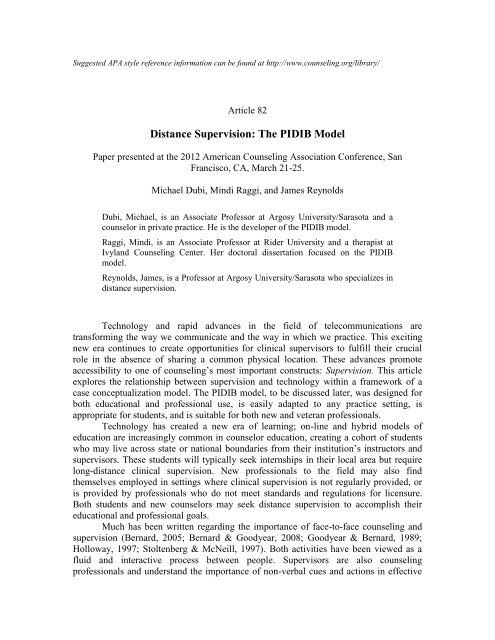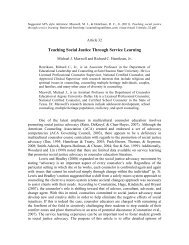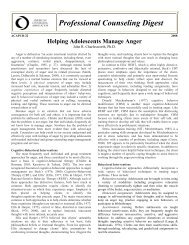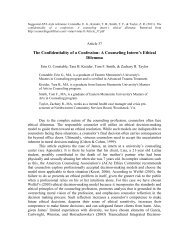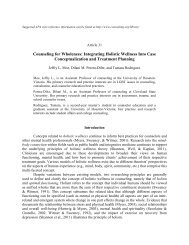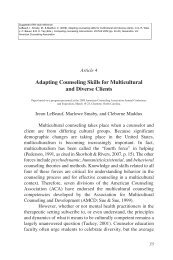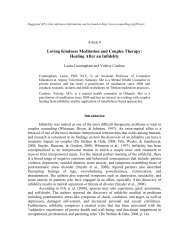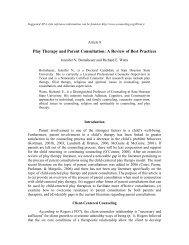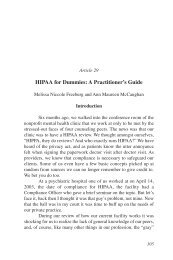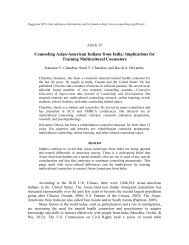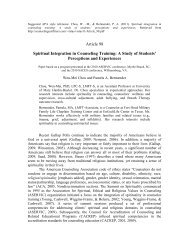Distance Supervision: The PIDIB Model - Counselingoutfitters.com
Distance Supervision: The PIDIB Model - Counselingoutfitters.com
Distance Supervision: The PIDIB Model - Counselingoutfitters.com
Create successful ePaper yourself
Turn your PDF publications into a flip-book with our unique Google optimized e-Paper software.
Suggested APA style reference information can be found at http://www.counseling.org/library/<br />
Article 82<br />
<strong>Distance</strong> <strong>Supervision</strong>: <strong>The</strong> <strong>PIDIB</strong> <strong>Model</strong><br />
Paper presented at the 2012 American Counseling Association Conference, San<br />
Francisco, CA, March 21-25.<br />
Michael Dubi, Mindi Raggi, and James Reynolds<br />
Dubi, Michael, is an Associate Professor at Argosy University/Sarasota and a<br />
counselor in private practice. He is the developer of the <strong>PIDIB</strong> model.<br />
Raggi, Mindi, is an Associate Professor at Rider University and a therapist at<br />
Ivyland Counseling Center. Her doctoral dissertation focused on the <strong>PIDIB</strong><br />
model.<br />
Reynolds, James, is a Professor at Argosy University/Sarasota who specializes in<br />
distance supervision.<br />
Technology and rapid advances in the field of tele<strong>com</strong>munications are<br />
transforming the way we <strong>com</strong>municate and the way in which we practice. This exciting<br />
new era continues to create opportunities for clinical supervisors to fulfill their crucial<br />
role in the absence of sharing a <strong>com</strong>mon physical location. <strong>The</strong>se advances promote<br />
accessibility to one of counseling’s most important constructs: <strong>Supervision</strong>. This article<br />
explores the relationship between supervision and technology within a framework of a<br />
case conceptualization model. <strong>The</strong> <strong>PIDIB</strong> model, to be discussed later, was designed for<br />
both educational and professional use, is easily adapted to any practice setting, is<br />
appropriate for students, and is suitable for both new and veteran professionals.<br />
Technology has created a new era of learning; on-line and hybrid models of<br />
education are increasingly <strong>com</strong>mon in counselor education, creating a cohort of students<br />
who may live across state or national boundaries from their institution’s instructors and<br />
supervisors. <strong>The</strong>se students will typically seek internships in their local area but require<br />
long-distance clinical supervision. New professionals to the field may also find<br />
themselves employed in settings where clinical supervision is not regularly provided, or<br />
is provided by professionals who do not meet standards and regulations for licensure.<br />
Both students and new counselors may seek distance supervision to ac<strong>com</strong>plish their<br />
educational and professional goals.<br />
Much has been written regarding the importance of face-to-face counseling and<br />
supervision (Bernard, 2005; Bernard & Goodyear, 2008; Goodyear & Bernard, 1989;<br />
Holloway, 1997; Stoltenberg & McNeill, 1997). Both activities have been viewed as a<br />
fluid and interactive process between people. Supervisors are also counseling<br />
professionals and understand the importance of non-verbal cues and actions in effective
Ideas and Research You Can Use: VISTAS 2012<br />
<strong>com</strong>munication. A learning curve still exists for supervisors with regard to effectively<br />
utilizing current trends of technology while not <strong>com</strong>promising the openness, trust<br />
building, and enhanced <strong>com</strong>munication that face-to-face contact provides.<br />
Clinical <strong>Supervision</strong><br />
Clinical <strong>Supervision</strong> is defined as an intervention provided by a more senior<br />
member of a profession to a more junior member or members of the same profession.<br />
This relationship is evaluative, extends over time, and has the simultaneous purposes of<br />
enhancing the professional functioning of the more junior person(s), monitoring the<br />
quality of professional services offered to clients, and serving as a gatekeeper for those<br />
who are entering a particular profession (Bernard & Goodyear, 2004).<br />
<strong>Supervision</strong> has clearly emerged as a counseling specialty. Professionals continue<br />
to identify, define, and refine the purposes of supervision: to facilitate, promote and<br />
ensure <strong>com</strong>petency, to protect client welfare, to assist in professional development and<br />
licensure, to prevent and identify <strong>com</strong>passion fatigue and impairment, and to assist in<br />
personal growth. (Bernard, 2005; Bernard & Goodyear, 1992, 2008; Goodyear &<br />
Bernard, 1989; Falender & Shafranske, 2008; Holloway, 1997; Stoltenberg & McNeill,<br />
1997). <strong>The</strong> gatekeeper role of clinical supervision has been well defined. Supervisors are<br />
charged with the responsibility of ensuring that consumers of mental health services<br />
receive these services effectively and professionally (Carroll, 2004). Counselors must<br />
have the skills to engage in a positive therapeutic alliance; possess an adequate<br />
theoretical knowledge base; and be aware of, and <strong>com</strong>petent to employ, a variety of<br />
interventions. <strong>The</strong>re are several roles supervisors engage in while working with both<br />
students and other professionals that ensure this <strong>com</strong>petency, as well as validating the<br />
gatekeeper role. <strong>The</strong> supervisor/teacher has the opportunity to instruct supervisees in both<br />
theory and interventions, often offering a new or novel way to approach the client’s<br />
<strong>com</strong>plaints. <strong>The</strong> supervisor/counselor has opportunities to model effective engagement<br />
and reflection of feelings. Issues of transference and countertransference are frequent<br />
topics in supervision as well, since supervisees are helped to examine their reactions,<br />
biases, and concerns while working with clients. Finally, the supervisor/consultant has<br />
opportunities to validate a supervisees’ approach, to assist in case formulation, and to<br />
provide professional and collegial support. <strong>The</strong>se roles and interactions with supervisees<br />
allow the clinical supervisor to evaluate <strong>com</strong>petency, to share relevant experience, to<br />
protect consumers, and to have final responsibility for clients served by supervisees<br />
(Bernard & Goodyear, 2008). Supervisors are crucial to the professional licensure<br />
process as well. Licensure is generally regarded as the process that serves to ensure that<br />
the public is not subjected to services of a sub-standard nature. Counselors are often<br />
engaged in facilitating life-changing directions and decisions with clients. <strong>The</strong> decision to<br />
begin counseling is often a difficult one and may be arrived at while an individual feels<br />
frightened, vulnerable, and isolated. <strong>The</strong> licensing process ensures that a minimum of<br />
education and practical knowledge has been achieved, and serves to ensure that all clients<br />
receive effective help when in crisis. Professional organizations, such as the American<br />
Counseling Association, acknowledge state regulations for obtaining licensure. Such<br />
supervision may be obtained at an employment site, by engaging in a private supervision<br />
contract, and in a <strong>com</strong>bination of group and individual encounters. Licensure is also<br />
2
Ideas and Research You Can Use: VISTAS 2012<br />
necessary to contract with third party payers and is often required at both public and<br />
private practice sites. <strong>The</strong> importance of licensure increases the need for accessible<br />
supervision.<br />
Counselors practice in many different settings and locations. In rural areas, a<br />
counselor may be a sole practitioner and be isolated from available peer support and<br />
supervision. Practitioners in urban areas may practice in agencies where a licensed<br />
colleague is not available to provide supervision. Counseling students may be practicing<br />
in agencies geographically removed from their instructors. Technological and web-based<br />
modalities, such as e-mail and audiovisual connections, provide opportunities for these<br />
counselors to obtain both required supervision and needed professional support.<br />
<strong>The</strong>re is much in the professional literature regarding <strong>com</strong>passion fatigue and<br />
vicarious trauma; clinical supervision and supervision for the supervisor does much to<br />
mitigate the possibilities of burnout (DePass, 2005; Horrell, Holohan, Didion, & Vance,<br />
2011; Knudsen, Ducharme, & Roman, 2008). In the last decade, counselor impairment<br />
has also been identified as a situation requiring supervision. Impairment affects both<br />
counselor and client and ACA has been involved in identifying opportunities to develop<br />
strategies to help. “Counselor heal thyself” is a dangerous concept for the profession.<br />
Counselors often feel that they are immune to emotional or behavioral struggles due to<br />
their strong knowledgebase regarding developmental stages, grief and loss, and<br />
resiliency. Counseling professionals may also view mental health difficulties as issues<br />
they should be able to handle independently because of their skills. Both perspectives<br />
place both students and professionals at risk.<br />
Avoiding impairment requires counselors to recognize and enhance their personal<br />
strengths, to identify client populations or issues that hold particular concerns to them,<br />
and to develop ongoing strategies to address these concerns. <strong>Supervision</strong> is critical to<br />
achieving these important professional and personal standards. <strong>The</strong> development of<br />
empathy is a critical skill to promoting engagement. It is often this same quality that can<br />
induce impairment. At the same time, practice sites and managed care payers may request<br />
that staff increase caseloads and productivity. Clinical supervision builds on a counselor’s<br />
strong points, whether they are theoretical interventions or reflective listening. <strong>The</strong><br />
supervisor provides opportunities to debrief on a regular basis, providing outlets for<br />
personal concerns arising from client contact. <strong>Supervision</strong> in order to address these<br />
concerns is critical to both students and new professionals. Even veteran counselors are<br />
helped to maintain perspective by engaging in regular supervision.<br />
Several counselor education programs have additionally created curricula that<br />
include “therapy-like” classes or workshops for counselor personal growth. Similar to the<br />
factors that may lead to <strong>com</strong>passion fatigue, counselors and counseling students must<br />
be<strong>com</strong>e aware of, and maintain awareness of, their biases, unresolved childhood issues,<br />
and historical mistakes in order to remain effective and client focused.<br />
<strong>Supervision</strong> is crucial, and tele<strong>com</strong>munication provides an opportunity to ensure<br />
that all professionals have access to this relationship, with convenience, flexibility and<br />
accessibility.<br />
3
Ideas and Research You Can Use: VISTAS 2012<br />
Technology, <strong>Supervision</strong>, and <strong>PIDIB</strong><br />
Technology continues to play an increasingly important role in the counseling<br />
profession. Along with the development and utilization of technological innovations in<br />
the delivery of online counseling services, and the use of the Internet in counselor<br />
education distance learning, clinical supervision is also undergoing a significant<br />
technological evolution. It seems clear that technology will continue to significantly<br />
influence the manner in which counseling students and counseling interns will experience<br />
their educational and training objectives.<br />
<strong>The</strong> modality of online supervision, referred to as cybersupervision by Watson<br />
(2003), is not a recent phenomenon. For roughly the past decade, distance supervision has<br />
been advanced in a number of different delivery software systems. With the Internet,<br />
distance supervision can be provided by any number of synchronous (live and in realtime)<br />
methods, such as utilization of streaming video, webcam, or threaded discussions.<br />
Asynchronous (different or delayed time) methods of providing supervision include<br />
listservs, email <strong>com</strong>munications, discussion threads, etc. <strong>The</strong>re are a variety of different<br />
Internet software platforms available that have been utilized in the delivery of<br />
cybersupervision, including BlackBoard, Illuminate Live, WebCT, GoToMeeting, and<br />
Adobe Connect. This article discusses the <strong>PIDIB</strong> model in clinical supervision utilizing<br />
Adobe Connect software as an online platform.<br />
Advances in Web-based Technologies<br />
Historically, methods of providing clinical supervision have utilized live real-time<br />
meetings, as well as the use of ancillary tools, such as one-way mirrors, audio tapes, and<br />
videotaped observations. Due to technological advances, it is now possible for clinical<br />
supervision to be delivered in real-time, even though supervisor and supervisee may be<br />
geographically distant. <strong>The</strong> technological advances that have occurred over the past<br />
decade have resulted in greater technical sophistication with both supportive hardware<br />
and software, as well as bringing cost considerations within the reach of many programs.<br />
Our Use of Technology for <strong>Distance</strong> <strong>Supervision</strong><br />
Our counselor education program (Argosy University, Sarasota, FL) offers a<br />
CACREP accredited master’s degree in Mental Health Counseling, as well as a CACREP<br />
accredited doctorate in Counselor Education and <strong>Supervision</strong>. <strong>The</strong>se programs offer<br />
course delivery in several formats, including online, blended, and on-campus formats.<br />
<strong>The</strong> software platform that our counselor education program uses for clinical<br />
supervision of practicum and internship students is Adobe Connect Pro. This software is<br />
available for purchase with several options regarding capacity and price. Our program<br />
has chosen to use the package that allows for up to 20 simultaneous individual webcam<br />
screens and costs around $40 per month. This software platform allows the Director of<br />
Training to host real-time meetings with audio and video interaction with intern students<br />
no matter where they are. <strong>The</strong> Director of Training is able to create a meeting which<br />
utilizes a “virtual room,” with the option of allowing only registered users and selected<br />
guests to enter the virtual room. To protect privacy and confidentiality, the host can<br />
manage access, or if desired, can block in<strong>com</strong>ing attendees. <strong>The</strong> room is initially created<br />
by identifying a name, and a specific day and time of the meeting. Participants are sent an<br />
4
Ideas and Research You Can Use: VISTAS 2012<br />
email invitation with the identifying URL. <strong>The</strong> host can select a variety of different<br />
layouts depending upon desired features. <strong>The</strong>se features include: audio and video realtime<br />
<strong>com</strong>munication, PowerPoint presentations, shared documents, upload files, written<br />
chat function, whiteboard, web links, etc. <strong>The</strong> meetings can also be recorded. For full<br />
participation, students will need the basic equipment of <strong>com</strong>puter with Internet access,<br />
webcam, and microphone. In addition, the free Adobe Flash Player is needed to attend an<br />
Adobe Connect Pro meeting. While there are several other software platforms available<br />
which offer similar capabilities, we have found that Adobe Connect Pro offers us the<br />
tools to provide synchronous <strong>com</strong>munication with students and supervisees. We have<br />
found that this technology makes it possible to not only maintain scheduled ongoing<br />
supervision of our practicum and intern students, but it also provides an effective virtual<br />
classroom in which to teach methods of case conceptualization. One particular method,<br />
the <strong>PIDIB</strong> model, has been developed, researched, and taught by utilizing this distance<br />
learning technology.<br />
<strong>The</strong> PDIB <strong>Model</strong><br />
Why does <strong>PIDIB</strong> lend itself so well to distance supervision? Because of its<br />
simplicity, it is easy to teach and learn and can be applied immediately to most clinical<br />
situations even with new interns. From the beginning of the supervision process,<br />
supervisor and supervisee are speaking the same clinical language regardless of their<br />
theoretical preferences. This provides for reliable and valid case conceptualization which<br />
forms the basis of the client’s treatment plan. In addition, the model is client and<br />
supervisee centered and empowering which helps to build confidence in the supervisee.<br />
<strong>The</strong> <strong>PIDIB</strong> model of clinical supervision <strong>com</strong>es from work done with trauma<br />
survivors and was inspired by the stages of trauma recovery of these survivors. <strong>The</strong>se<br />
stages are safety, control, responsibility, and self-esteem (R. Solomon, personal<br />
<strong>com</strong>munication, May, 2000). <strong>PIDIB</strong> is an acronym derived from the first letter of each<br />
phase of the model (see below). <strong>PIDIB</strong> can be used in almost all supervision venues<br />
because it is a transtheoretical model (Raggi, Dubi, & Reynolds, 2008). <strong>The</strong>refore it<br />
encourages supervisor and supervisee to <strong>com</strong>municate using a <strong>com</strong>mon worldview. It is a<br />
user-friendly model that is especially useful in helping new or inexperienced counselors<br />
work with clients. It is a simple model that allows for easy and reliable case<br />
conceptualization—supervisees do not need expertise in diagnosis. Hubble, Duncan, and<br />
Miller (1999) believe that diagnoses have never been related to change in any way and<br />
are not particularly useful to counselors at any level.<br />
<strong>The</strong> five phases of <strong>PIDIB</strong> are: Presenting Problem, Issues, Dynamics,<br />
Interventions, and Bridge.<br />
Phase I: <strong>The</strong> Presenting Problem is the first phase of <strong>PIDIB</strong> and drives the other<br />
phases. It uses the client’s words and does not allow for any interpreting by the counselor<br />
(or the supervisor).<br />
Phase II: Issues refers to safety, control, responsibility, self-esteem, and reality<br />
testing. <strong>The</strong>se issues are driven by the client’s presenting problems and are what the<br />
counseling sessions will focus on in place of a formal diagnosis. It allows treatment to<br />
proceed immediately in a meaningful way.<br />
5
Ideas and Research You Can Use: VISTAS 2012<br />
Safety includes physical and psychological safety and often resembles PTSD in<br />
the client’s presentation. This, in fact, may be the most powerful of all issues and the<br />
most difficult to treat.<br />
Control refers to the clients feeling out of control, having no control, or being<br />
controlled by others, and is a <strong>com</strong>mon issue. Substance abuse, for example, is an example<br />
of a control issue.<br />
Responsibility usually refers to guilt and shame in this model. With guilt the<br />
action is the focus of evaluation whereas with shame, the self is always the focus of the<br />
evaluation.<br />
Self-esteem is part of an individual’s schemata and may have its roots in early<br />
childhood. In any case, high self-esteem tends to make the individual feel good and it is a<br />
<strong>com</strong>mon issue in counseling.<br />
Reality testing refers to mental illness and usually requires medical intervention.<br />
<strong>The</strong> burden of proof here is very low—you do not have to prove, you only have to<br />
suspect—to make the referral. However, most clients with reality testing issues have<br />
already been seen medically and may already be taking medication.<br />
To determine if you need to make the referral, the counselor must ask the<br />
following questions: Is the client hallucinating? Is the client delusional? Is the client<br />
suicidal? Is the client homicidal? Is the client consuming toxic substances in a harmful<br />
manner? A yes to any of these questions would suggest a reality testing problem.<br />
Phase III: Dynamics refers to the session interactions between the counselor and<br />
client. <strong>The</strong>se dynamics often change within and between sessions and are often<br />
unconscious in nature. However, dynamics determine the strength of the therapeutic<br />
alliance. Good dynamics permit you to continue with treatment.<br />
Phase IV: <strong>The</strong> Interventions phase is driven by stages I, II, and III. It empowers<br />
the client by reflecting back on the issue(s) identified and permitting him/her to decide<br />
the issue to work on and to begin the process of healing.<br />
Phase V: <strong>The</strong> Bridge, or homework phase, connects sessions and strengthens<br />
learning. It provides the client with therapeutic activities between formal sessions and,<br />
again, empowers the client with control over therapy.<br />
<strong>The</strong> <strong>PIDIB</strong> model fits into the cybersupervision protocol with the supervisor<br />
asking the supervisee to identify the presenting problem(s), issues, and dynamics and<br />
then asking about the client’s choice of issues and interventions used. Because the<br />
presenting problems begin the session, all that follows must be reliable. That is, the<br />
counselor confirms with the client if the issues are correctly identified and then asks<br />
which issue the client would like to work on first. This client centered, client empowering<br />
model allows the session to be focused and goal oriented. It allows the supervisor to<br />
determine counselor effectiveness in both case conceptualization and treatment.<br />
<strong>The</strong> <strong>PIDIB</strong> model is a natural match for cybersupervision because of its ease of<br />
teaching and ease of learning within the context of clinical supervision. Supervisors must<br />
be aware of what the client is actually experiencing and the direction of the counseling<br />
process which the model efficiently provides. So far the response from supervisors has<br />
been very encouraging.<br />
6
Ideas and Research You Can Use: VISTAS 2012<br />
References<br />
Bernard, J. M. (2005). Tracing the development of clinical supervision. <strong>The</strong> Clinical<br />
Supervisor, 24, 1-2.<br />
Bernard, J. M., & Goodyear, R. K. (1992). Fundamentals of clinical supervision. Boston,<br />
MA: Allyn & Bacon.<br />
Bernard, J. M., & Goodyear, R. K. (2008). Fundamentals of clinical supervision (4th<br />
ed.). New York, NY: Pearson.<br />
Carroll, M. (2004). Counseling <strong>Supervision</strong>: <strong>The</strong>ory, skills and practice. Los Angeles,<br />
CA: SAGE.<br />
DePass, C. M. (2005). Vicarious trauma in correctional mental health staff. Carlos<br />
Albizu University. ProQuest Dissertations and <strong>The</strong>ses, 91 p.<br />
Falender, C. A., & Shafranske, E. P. (Eds.) 2008. Casebook for clinical supervision: A<br />
<strong>com</strong>petency-based approach. Washington, DC, US: American Psychological<br />
Association.<br />
Goodyear, R. K., & Bernard, J. M. (1989). Clinical supervision: Lessons from the<br />
literature. Counselor Education & <strong>Supervision</strong>, 38 (1), 6-22. doi:<br />
10.1002/j.15566978.1998.tb00553.x<br />
Holloway, E. L. (1997). Structure for the analysis and teaching of supervision. In C. E.<br />
Watkins, Jr. (Ed.), Handbook of psychotherapy supervision (pp. 249-276). New<br />
York, NY: Wiley.<br />
Horrell, S. C. V., Holohan, D. R., Didion, L. M., & Vance, G. T. (2011). Treating<br />
traumatized OEF/OIF veterans: How does trauma treatment affect the clinician?<br />
Professional Psychology: Research and Practice, 42(1), 79.<br />
Hubble, M. A., Duncan, B. A., & Miller, S. D. (1999). <strong>The</strong> heart and soul of change:<br />
What works in therapy. Washington, DC: American Psychological Association.<br />
Knudsen, H. K., Ducharme, L. J., & Roman, P. M. (2008). Clinical supervision,<br />
emotional exhaustion, and turnover intention: A study of substance abuse<br />
treatment counselors in the clinical trials network of the national institute on drug<br />
abuse. Journal of Substance Abuse Treatment, 35(4), 387.<br />
Raggi, M., Dubi, M., & Reynolds, J. W. (2008). <strong>The</strong> use of a pantheoretical case note<br />
format as a clinical tool. <strong>The</strong> New Jersey Journal of Professional Counseling, 60,<br />
5-11.<br />
Stoltenberg, C. D., & McNeill, B. W. (1997). Clinical supervision from a developmental<br />
perspective: Research and practice. In C. E. Watkins (Ed.), Handbook of<br />
psychotherapy supervision. New York, NY: Wiley.<br />
Watson, J. C. (2003). Computer-based <strong>Supervision</strong>: Implementing <strong>com</strong>puter technology<br />
into the delivery of counseling supervision. Journal of Technology and<br />
Counseling, 3(1). Retrieved from http://jtc.columbusstate.edu/vol3_1/<br />
Watson/Watson.htm<br />
Note: This paper is part of the annual VISTAS project sponsored by the American Counseling Association.<br />
Find more information on the project at: http://counselingoutfitters.<strong>com</strong>/vistas/VISTAS_Home.htm<br />
7


